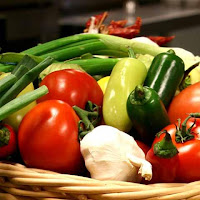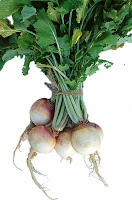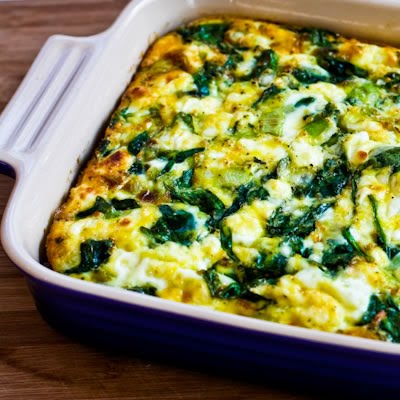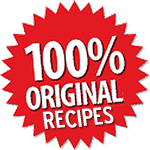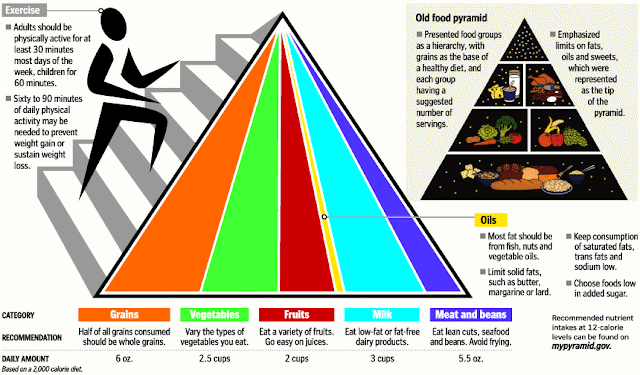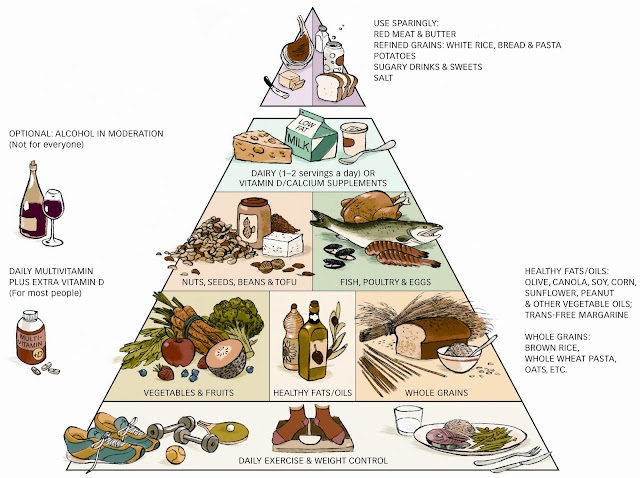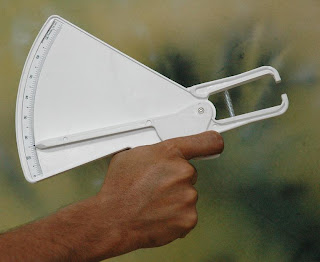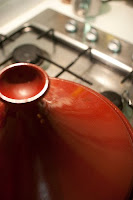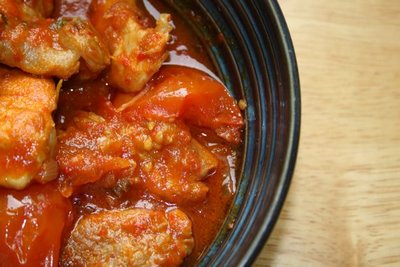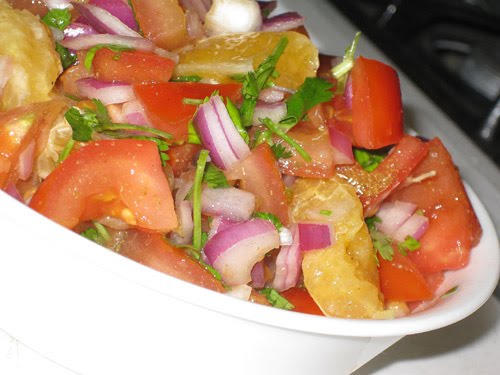Wednesday, March 17, 2010
0 Jamie Oliver's Food Revolution

I just caught the ad for the new ABC show, Jamie Oliver's Food Revolution, which will be airing its debut episode next week, on Friday, March 26th. The show is about Jamie Oliver's efforts to get Americans to eat healthier. Of course, you knew I was going to post about this. :-D
Here's a sneak peek of the show, if you haven't seen it already:
The last two posts I wrote on this blog are eerily similar in subject matter to the above show. I honestly didn't see the ad for the TV show (or know anything about it!) before I wrote those two recent two posts on healthy eating & nationwide food reform initiatives. It's such a strange coincidence! Well, guess I'm already part of the food revolution. :-D
Tuesday, March 16, 2010
0 Recipe #90: Fatayer Bi Sabanekh (Spinach Popovers)

Fatayer Bi Sabanekh (خنابسلأ رئاطف), or spinach popovers/triangles are one of my favorite mezze to order at the local Lebanese restaurant a few blocks down from us. The only problem is that the dough is loaded with fat. This probably explains why I don't eat them that often. :) So of course, I'm going to give you a recipe for a much healthier version here. :) As most of you already know, I believe that recipes have got to taste good no matter how healthy they are, so it follows that recipes here will also follow the same criterion! :) OK, on to the recipe!
Fatayer Bi Sabanekh (Spinach Popovers)
Dough Ingredients:
1 tsp. active dry yeast
1 tsp. brown sugar
1/4 c. lukewarm water (110-115°F)
1/4 c. milk
1 T. extra virgin olive oil
1 1/4 c. flour
1/2 tsp. salt
Filling Ingredients:
1 c. cooked & drained spinach, densely/tightly packed & finely chopped (To make, use 1 lb. fresh spinach or 10 oz. frozen)
1 c. yellow onion, finely chopped (about 1/2 an onion)
juice of 1 lemon
1 Tbsp. extra virgin olive oil
1 1/2 Tbsp. pine nuts
1 Tbsp. ground sumac
1 tsp. paprika
1/2 tsp. ground nutmeg
1/2 tsp. dried thyme leaves
1/2 tsp. dried mint leaves
1/4 tsp. cumin
1/4 tsp. ground black pepper
(1/4 tsp. salt, but only if the type of sumac you use doesn't already contain salt - Check sumac ingredients first before adding.)
Directions: Proof yeast with lukewarm water & sugar. It's very important that you use fresh yeast & lukewater warm (110-115°F), & follow the instructions for making the dough in the proper sequence as written; if water is boiling hot or if salt is added directly to the yeast, it will kill the yeast instantly. (Also, I don't use milk to proof, as it tends to create lumps.) If yeast mixture doesn't start bubbling within 5 minutes, it's usually dead. Start over with a new batch of yeast. ;) Let mixture proof for about 10-15 minutes. [If you've never done this before or need a refresher, please see this website for more useful & very important tips.]
While you're waiting for the yeast to proof, measure milk & allow it to reach room temperature. Set aside. Sift flour into a separate, large bowl, & then mix in salt. When yeast has finished proofing, add milk to yeast mixture & let sit for another few minutes. Then the add liquid mixture to flour mixture, & stir in olive oil. Form a dough ball & knead for several minutes until the dough is soft & pliable but not overly sticky or dry. If necessary, add a touch more flour or water to reach proper consistency. Place dough back into bowl & cover with plastic wrap; if you're using a plastic bowl, you'll probably want to place a large rubber band around bowl to secure. (You can also use a towel, but I find that the plastic wrap is the most effective method for keeping the dough moist.) Let dough rest for an hour or more.
While dough is rising, mix together filling ingredients in a separate bowl & then set aside. I cannot stress enough HOW important it is that you squeeze out ALL of the liquid from the spinach after cooking it. If you're using frozen, a good method is to let it thaw out & then cut open a small hole in the bottom of the bag for squeezing out the liquid. You can also use a strainer, but I find that squeezing the spinach towards the top of the bag & letting the water drain through the bottom works really well. :) Please note that if the mixture is to wet, the turnovers will be difficult to seal together & may also open up in the oven during baking.
Cut the dough in half and roll the first half onto a floured surface, until it reaches 1/16 of an inch. It's very important to roll out the dough as thin as humanly possible; otherwise the popovers will be heavy & dough-y, & no one wants that! :) If you have difficulty getting them paper-thin, try to at least get them to 1/8 of an inch or thinner.
Useful Tip: If you roll dough onto floured wax paper instead of directly onto your countertop, you can just wrap up the paper ends & discard when finished. It saves cleanup time -- one less thing to clean. And I think we can all agree that that's a good thing. :)
Use round cookie cutter or large glass that's at least 4" in diameter. If you're using a glass, be sure to place the glass flush with the dough & then gently rotate/roll the glass's edge around in a circle to make dough cut-outs.
Keep rolling out the remaining dough in batches, reusing the unused cutouts & repeating the procedure until all of the dough has been used up.
When all the cut-outs have been finished, you can work each dough circle & stretch it out with your fingers a bit more before adding the filling, in order to make the popovers easier to close.
Next, place a spoonful of filling onto each dough circle; don't overfill or ends will get wet & will be difficult to seal. On that note, flour your hands really well after you complete this step. :) Then lift the popover ends & pinch 2 sides together & then the third side to form a pyramid shape. (Useful Tip: If ends should come apart during sealing process, just dust flour on the inside ends & reseal.)
(When finished, they should resemble hamentaschen, if you've ever seen those before. Of course, the main difference is that popovers are completely sealed, whereas hamentaschen have poppy seed filling poking out of the top center. Samosas, while triangle-shaped, are configured & sealed a bit differently, so they don't really look the same. ;) )
Preheat over to 375°F. Place sealed popovers onto a greased baking sheet. [Useful Tip: Instead of greasing with butter or nonstick cooking spray, I use a Misto spray can filled with olive oil, which is much healthier. As many of you already know, Teflon pans & non-stick aerosol sprays (like PAM) contain a chemical known as perfluorooctanoic acid (or PFOA), which is potentially unhealthy, especially since it's been known to peel off & bond to food. Now while the verdict's still out on PFOA's long-term effects, it's probably best not to chance it. I don't know about you, but I certainly wouldn't want that stuff in my stomach. In general, I try to steer away from ingesting chemical compounds whenever I can help it, whether they be found in food, the air, or household objects. ;-) ]
Place baking sheet into oven & bake for 25-30 minutes, or until popovers turn a golden brown color. (Please note, there's no need to flip them over; if you cook them long enough, both the tops & bottoms will brown.)
Bake in batches & let them cool a bit. Popovers should be slightly warm when eaten.
Yield: Makes about 25-30 popovers, depending on how thin you roll the doll. :)
Chef's Notes/Tips: Popovers can be frozen for a month or two, or even longer. Wait until they cool completely before placing them into Ziploc bags. Also, after you thaw them out, be sure to poke holes in the top of the popovers to let the condensation escape, or you're going to have some rather soggy popovers. :)
To make this recipe even more low-fat, you could substitute walnuts & almonds for the pine nuts. If allergic to tree nuts, you can try substituting soy nuts. I haven't tried it before myself, but I bet they'd probably work.
Also, if you have any left-over spinach filling after you're done making the popovers, the mixture by itself tastes really good either raw or cooked; you can serve it along with rice or couscous as a side for lunch or dinner. If you're going to eat it raw, be sure that the mixture has had adequate time to marinate (i.e., 30-60 minutes), as the acid in the lemon juice needs time to "cold-cook" the onions. Otherwise, the mixture is going to be really strong, & so will your breath. ;-)
Monday, March 15, 2010
0 Hmmmm, Interesting.....

It looks like the article I posted yesterday, "My Definition of Healthy Food," has created something of a stir.
Well, good! It was meant to make people think. :)
Let me be crystal clear about some things that I thought I'd made perfectly clear in this earlier article & on this blog in general: First, I think I stated fairly plainly that the lifestyle I chose to lead is my own & no one else's, nor am I seeking to force my own personal eating habits on anyone else. This is what works for me. I've illustrated that philosophy time again & again, both on this blog & the running blog. (Of course, if you only read just that single post, you might not realize that about me.) As one example, see an earlier article I'd written that discussed two very different approaches to eating -- calorie-counting & menu-planning (metric, left-brained approaches) versus other alternate (right-brained) approaches. For some people, the former method works best & for others, it's the latter. It's not a matter of right & wrong in that case; it's a matter of what works for the individual.
In other words, I am clearly NOT here to tell people that my way, when it comes to my own specific personal eating practices, is the only way. However, what I am advocating is a change in the public mindset at large when it comes to demanding better standards of health in this country, & around the world.
Personally speaking, I would like to think that the majority of my health practices are based largely/primarily on logic and science, versus emotions & hunches.
Furthermore, I would like to state for the record that I have a fairly "normal" relationship with food. In other words, I'm not extreme or self-torturing in my eating patterns, nor would I freak out & tank my nutritional plan for the week should I eat one too many brownies. :) If my eating should stray from its intended course, I'd simply just press the reset button, & keep moving forward. Literally, as in, I'd run it off. :) I believe that emotional self-flagellation & wallowing in one's mistakes serves no use. My motto: Just take the useful bits & discard the rest.
And like a normal-thinking healthy-minded person, I do splurge & have the occasional potato chip or brownie... or two. :-D As they say, everything in moderation. I'm not sure that this point came across in the previous article, but that's the reality.
Those of you who've been longtime readers of this blog &/or my running blog already know my position on things of this nature. I'm all about moderation and balance. I've probably used those two words in conjunction with each other a zillion times on these blogs & elsewhere.
Likewise, I never said that I was perfect or a health food saint. Having said that, my personal overall guiding principles & reference points are still predominantly health-focused. I've been that way for a long time.
To be honest, I didn't really feel like I was missing out because the meals my mother cooked were really delicious. Sure, I ate some sweets from time to time; I was kid. But it didn't rule my life.
I'm truly happy that our parents raised us this way. Heck, it certainly made things a lot easier for us later on in life. In many ways, my parents were well before their time. They could be called trailblazers, doing back then what a lot of people had to adapt to doing much later in life. And while none of us in our family claim to be perfect in our habits, it's certainly one less area in our lives to fuss over, as healthy eating/cooking is one healthy habit that's pretty much on autopilot by this point.
Also, alcohol consumption wasn't really part of my parents' lives, and still isn't. While I do enjoy the occasional glass or wine or beer, or a cocktail every now & then, it doesn't play a predominant role in my life. Sure, I enjoy learning about varietals, etc., but for me it's about the taste & not about the alcohol. I'm a mature grown-up who's got nothing to prove to others about my alcohol consumption. :-D What's really funny is that while I don't drink very often, what little I do drink -- i.e., maybe an occasional glass of wine or beer, or a cocktail every several months, unless I'm in training mode, in which case I tend to abstain -- is probably more than my parents typically drink in a few years' time. Haha!
Again, that's their choice, & this is mine. And neither party judges the other on that count, just as I don't judge my parents or my sister on what they choose to eat or not eat. I eat what I want to eat, & they do the same. And even though we all are healthy eaters, we each have our own ways of defining what that means to us as individuals.
I understand that what is normal to me is probably not "normal" to someone else, as not everyone was raised in the same manner nor did they grow up with the same conceptions of what healthy food is. That's precisely why I wrote the article: I was defining what healthy food is to me. Not what it means to someone else. Got it?! This is how I am, & I don't expect others to be "mini-me's." :-D
However, I am far from "extreme." Maybe some people think I am, but that's their own reference point. First, let's compare apples to apples & oranges to oranges. If you consider my reference point, that of other running coaches & runners/athletes, I have no doubt that you will find that my practices are actually fairly typical/commonplace, & furthermore, sanctioned/advocated by others in my field as well as medical & health professionals. And let's take that reference point to an ever more specific reference point: If you line my health habits up to the average female runners/athletes/running coaches, you will actually find that within this frame of reference, my viewpoints are far from extreme. If anything, I am more moderate as compared to a lot of exercisers who obsess about weight-loss to an unhealthy extreme.
I have never been shy about my stances on any health-related topic, & am not about to start apologizing for my point of view now. My main focus has always been on complete health & preventative care -- and yes, healthy eating & exercise are a large part of that picture. However, I do recognize a distinction between my own viewpoint on health matters at large & the specific choices that I and other health-focused people have made. Again, let's look at apples & apples, not apples & oranges.
Most of you who read my running blog & follow me on Twitter & Facebook already know that my bone of contention is primarily with those people & organizations who advocate unhealthy lifestyles & actively work -- both indirectly & directly -- against the public's welfare in both private & legislative capacities (read, special interest lobbies) to ensure that these standards stay "the norm." Yes, these entities do exist. And you can be sure that I will go head-to-head with them, both personally & professionally. I will fight these people in my own local community, and also on national & global levels as well.
I have no doubt in my mind that those who seek to block the efforts of others seeking to 'raise the bar' of health & food safety standards in this country will ultimately fail. They are fighting a losing battle. The truth will always find a way to be free. Those who act out of ego & fear, & are blinded by short-term profit motives instead of doing what is right and just.
So, it's on, baby! I'm not afraid of conflict, especially when trying to reverse the efforts of those who seek to keep the public ignorant of health & safety concerns or food industry practices.
And that includes the multi-million-dollar diet industry & any multimedia outlets (i.e., fashion rags, etc.) supporting their unsound practices. It's not secret that I have an ax to grind with them as well: I'm vehemently opposed to those who advocate crash diets, diet pills, etc., & the dieting-mentality in general. They have wielded a huge cultural influence, & it's time for them to start being responsible. The exercise, diet, & food industries need to turn that ship around & there are many in these industries that need to wake the hell up. To these people, I say stop endorsing short-term results & obsessively focusing on weight-loss as the sole goal. It is not the only pinnacle or point of healthy eating & exercise. What about the sublime satisfaction in the movement of our bodies -- the sake of the pure joy of physical motion for its own sake? That's the part that health & exercise professionals should promote. Not some unrealistic pipe dream of a perfect existence without effort, error, experimentation, or adversity.
If anyone was trying to sell you "smoke & mirrors," it's these guys. Please note that I'm NOT talking about everyone in the industry, just the kooky ones that have no clue. :) Remember the adage, "if someone's trying to sell you something that sounds to good to be true, it usually is"? Well, it's common-sense, really. If a diet-system were another purchase, let's say a timeshare rental property, wouldn't you think twice & scrutinize their offer more carefully before signing up?! And really, exercise & healthy eating are an investment in the health of your body. What could be more important?!
Lose the remaining 30 lbs. in 2 weeks? C'mon. Whether or not it's possible isn't even the central issue here. But your health surely is. Most of us know that rapid weight loss is almost always temporary, & very unhealthy to boot. However, the concepts of knowing something & acting upon that knowledge are often clearly two entirely separate things. :)
A short-term diet-&-exercise focus is a recipe for disaster/failure. It's been proven again & again, & yet some people refuse to face the evidence staring them in the face. Want a recipe for success instead? Apply the following basic, common-sense principles: Gradually increase your levels of physical exercise. Eat & exercise for long-term health. versus a sole focus on weight-loss. While maintaining healthy body fat percentage is clearly important to one's health, I think that there are still way too many people who obsess far too much about the superficial aspects of losing weight when they should be focused on healthy eating & exercise, with weight-loss as a by-products of those actions. The irony is that when weight-loss is a by-product, instead of the end-goal, one's efforts & newly formed behaviors tend to have a lasting effect. Take baby steps towards your exercise goals, & literally put one foot in front of the other. Seek moderation & balance, instead of quick results.
As I've stated/written before on numerous occasions, there are still far too many ads & articles in the media that are focused on the wrong end of the process of getting fit & maintaining a healthy body weight. And yes, that includes those ridiculously unsound ads on late-night TV. Of course, a lot of these ads are shown at all hours of the day & night. I've even seen some of these ads on FitTV -- you think as exercise professionals that they'd know better!
In general, I'd advise thinking twice before buying into anyone's diet-&-exercise system. Because you're buying into a mentality & a philosophy as well. This careful consideration applies to anything from exercise machine purchases to meal-systems. It's not just the obvious stuff -- like diet pills & the like -- that I'm talking about here. Do your reading & talk to certified health/fitness professionals who promote medically-sound health ideologies.
If people literally stop buying into the impractical nonsense that the diet industry is selling, they will be doing a great service to themselves & to society at large. Bad health ideas can only be perpetuated if people keep supporting them. Instead, let's make our lives healthier by supporting realistic, long-term solutions & demanding better standards from ourselves, our businesses, & communities.
There's no time like the present. We can generate new ideas & incentives, & be passionate about putting those ideas into action. It's no secret that this kind of enthusiasm attracts people, people who will want to become involved in the energy of creating & implementing solutions.
So interact with your elected representatives. Let them know what you think about these issues. Don't just complain. Offer solutions. Think creatively. Meet with other health-minded people; brainstorm with them, & put those ideas into motion.
Talk to your place of work about how making their workplace green can save them money, & suggest ideas for doing this. Companies without gym facilities can still work in conjunction with sports facilities to offer employee discounts for gym memberships, etc. See if your business can provide incentives for their employees to choose healthier lifestyles -- healthy employees who stay fit & take advantage of their vacation benefits are less likely to take sick days, which in turn, saves the company money in the long term. What can benefit an employee can also be beneficial to a company; it often just has to be phrased in the right way to make the management to see the light. Or, if they can't see the light, then maybe it's time to find that light elsewhere. And while this choice isn't necessarily for everyone, you can also consider re-aligning your vocation with an avocation you are passionate about. That's what I did.
Together we can address the clear & pressing need for healthy food options in this country -- in our homes, schools, & workplaces, etc. We can make this a reality through specific local action in our communities. There are several organizations -- both nonprofit & for profit -- that offer opportunities to participate in activities that promote health & truly make a monumental difference in the lives of others.
When you take action like this, you create a ripple effect. Your personal actions & choices inspire others. This is how one person can move a mountain. Choose to be an embodiment of good health, & you will be its ambassador.
0 Recipe #89: A Recipe For My Mother -- Grilled Carrots & Turnips Seasoned With Fresh Herbs & Spices

Now, if I took a poll of a random sampling of people -- let's say we were at a rock concert or a sporting event -- and requested, "Raise your hands if you like turnips!" I realize that not many people would probably raise their hands. If, right about now, you are imagining this percentage as the equivalent of a lone schoolchild raising their hand in class, then you are probably not far from the truth. :)
The turnip has the unfortunate distinction of being one of those vegetables that we all know is good for us, but none of us really look forward to eating. Let's face it: Turnips have gotten a bad rap, & along with lima beans & brussel spouts, were probably on most people's "DNR dinner menus." :) Part of the reason is that, uncooked, they have the same sharp, biting flavor as radishes, (which is a big turn-off for a heck of a lot of people), & after they are cooked, they are, OK, let's be honest, a little bland and often mushy (especially when overcooked!!!). Their flavor when cooked is akin to brussel sprouts, except without the unpleasant aftertaste. :)
Now if the above "testament to a turnip" isn't a ringing endorsement to make this recipe, I don't know what is. Hahaha! But seriously, the turnip is rarely on people's "most wanted" vegetables list, unless we are talking about criminal vegetables that were the bane of our childhood existences. They would probably rank right up there with liver on the "foods that children sincerely hope their parents will never force them to eat ever again." :-D
Also, on that note, if you grew up with a mother who didn't know how to properly cook turnips, & you were then scarred for life from the experience, then maybe that's not the turnip's fault. ;) A lot of us are brave enough to overcome our bad childhood food memories & associations, and give the foods we hated as children a second chance.
So why am I talking about all of this? Because I'd like to prove that there is hope for the lowly turnip after all. Heck, this is going to be my championing magnum opus to the turnip -- let's call it "Ode to A Turnip" (!) -- that would even make my mother proud.
In fact, I expressly mention my mother because not only does she happen to like turnips, but is also the one who brought us several turnips (among other farm-fresh vegetables, including the wild mushrooms I just used for two recent recipe creations) during their visit to see us last weekend. Now, I've got to find something to do with them, other than using them as temporary cat toys for Java & Cleo to chase after. JUST kidding.
While I will usually eat a turnip if presented to me in raw or cooked format, I think my mother forgot that it's the other sister who truly loves eating turnips. ;) Although admittedly not a huge fan of turnips myself, I am grateful for my mother's gesture and am determined to find a way to make them more appealing & exciting to both my own little family unit here in DC & also to the general public at large. It's the least I can do for healthy cooks everywhere (& their family members who might not have any choice in the matter!).
So take another chance on the turnip & give it your vote of confidence. And with that turnip-affirming introduction, I give you....
Grilled Carrots & Turnips Seasoned With Fresh Herbs & Spices
The saving grace of this recipe is the carrots, scallions, spices, & herbs. In other words, everything else surrounding the turnips is what is helping to make them more palatable. :) The carrots add a much needed sweetness, which offsets the flavor of the turnips, & in conjunction with the scallions, herbs, & lemon juice, help to round out the flavor of this dish considerably. Also, the sumac is absolutely essential to the overall flavor of this dish, so I strongly recommend that you not skip over this ingredient -- Its salty, tangy flavor completes this recipe; the kind I use already contains salt, so if the kind you use doesn't, just add a dash of salt & you'll be all set. Enjoy!
Ingredients:
1 Tbsp. extra virgin olive oil
1 turnip
1/2 c. whole baby carrots
1/2 c. water (or more, if necessary)
2 scallions, sliced horizontally into rounds
1 tsp. sumac
1/4 tsp. lemon juice
1 large fresh sage leaf, torn into small pieces
1 sprig fresh oregano, leaves only
1 sprig thyme, leaves only
Directions: Sauté baby carrots & turnips in olive oil on medium heat for 5-7 minutes, or until slightly softened but yet still firm & crunchy. In other words, they should have the consistency of lightly steamed vegetables. Carrots can brown a little bit but don't let them burn. Turnips will most likely turn a light pink color; this is normal. Then add water, scallions, & fresh herbs & continue to cook until scallions soften (only a few minutes). Remove from heat. Add sumac & lemon juice, mix thoroughly, & serve. And that's it! You've got a tasty side dish that's not only different from the usual run-of-the-mill turnip preparations, but is also, in my opinion, far more tasty & exciting. :) Bon Appétit!
Yield: 1 serving.
Alternate Preparation Ideas: You can also grill this dish on an outside grill, which would be my preferred method were we to have easy access to an outside grill. Be sure to use a brush to lightly baste the vegetables with an olive oil & lemon juice mixture -- Please note that you may have to adjust the amounts of olive oil & lemon juice from what's actually listed above. (Obviously, the water will be an unnecessary ingredients for the grilling process itself.) Place the turnips & carrots on the grill first, since they will take the longest to cook. Don't add scallions until the last minute (literally), since they are more delicate & cook quickly; they really do cook in about a minute. The fresh herbs will very likely char on the grill, so I would instead recommend using the 1/2 c. water to blanch them in a sauté pan as a separate step. In this case, you'll want to blanch the herbs in their whole form on high heat for about 30 seconds to a minute. Then, drain the excess liquid & sprinkle the leaves on top of the grilled vegetables. (The sage leaf should still be torn into little pieces before adding it to the final product.) Combine the herbs & the veggies & mix everything together thoroughly. Then season with sumac, & serve.
Chef Notes: I made this for lunch (& also ate some protein to round out the meal) but it can also be made as a side dish for dinner.
Sunday, March 14, 2010
1 What's Next On The Horizon....

Here's just a tiny sampling of the recipes that I'm planning to create & post over the next few weeks:
In the next few days....
Grilled Carrots & Turnips Seasoned With Fresh Herbs & Spices
Fatayer Bi Sabanekh (Spinach Triangles) (Middle-Eastern)
Future recipe ideas.... [These are currently in the works, so it's anyone's guess when they'll be posted (!)]
Grilled, Marinated Vegetables
Sarada (Japanese salad; not sure exactly which variety I'm going to make just yet....Might do a few different ones. We'll see.)
Homemade, Mexican-Style Hot Chocolate
Chili Sauce (Chinese)
Guacamole (Mexican)
Tarte Abricot (Apricot Tart) (French)
The Cybertini Mocktail (Cyberpenguin's signature non-alcoholic drink :-D )
Helado de Tamarindo (Taramind Ice/Sorbet) (Mexican)
Italian Ice
Caruru de Camarao com Coentro (Shrimp & Okra with Nuts & Cilantro) (Brazilian)
Jugo de Maracuyá Con Leche (Passion Fruit Smoothie) (Colombian/Latin American)
Sopa de Platanos (Plantain Soup) (Latin American)
Upcoming recipes for the "Make It Healthier Challenge"....
And, yes at some point, I'm gonna get around to making the healthy versions of Panera's Orange Scones & restaurant-style General Tso's Chicken from the "Make It Healthier Challenge," as promised earlier. I'm just a little backlogged at the moment with my cookbook writing project....
0 Recipe #88: Crustless Spinach, Leek, & Feta Quiche (Crustless Quiche 2.0)

As you might recall, I posted a "barebones" quiche prototype a few weeks ago (i.e., back in late February), which I'd created in a pinch during a snowstorm. Fresh ingredients were scare, due to the Mid-Atlantic's mass "empty supermarket shelves" phenomemon, & so, I had to get rather creative with our dinners for a few days. :)
Now, that the situation is back to normal again, I thought I'd have a second go at making a crustless quiche recipe, this time with a more creative freedom & a wider range of ingredients from which to choose. :)
So, without further ado, I bring you...
Ingredients:
1/2 onion, finely diced
1 leek, sliced into horizontal rounds & then quartered
2 garlic cloves, peeled & minced
1/2 Tbsp. extra virgin olive oil
1/8 Tbsp. (or less) butter
1/4 c. sherry (or dry white wine)
1/2 c. cooked spinach (drained) (1 12 oz. bag fresh spinach will make about 1/2 c. cooked)
a pinch of salt
3 eggs
1/2 c. feta cheese
1/3 c. nonfat milk
1/3 c. light non-dairy creamer (or plain light/nonfat soymilk)
freshly ground black pepper, to taste
1/2 Tbsp. dried oregano leaves
1/2 Tbsp. dried thyme leaves
1/4 tsp. nutmeg
Directions: Preheat oven to 375° F. Sauté onion, leek, & garlic in olive oil on medium heat. Next, add sliver of butter (for flavor) & deglaze with sherry (or white wine). Stir in spinach & sprinkle a pinch of salt on top to help ingredients cook down a bit. Cook ingredients until soft; at this point, there should be all but a thin layer of liquid on the bottom of the pan. Set aside & let cool. In a separate bowl, beat together eggs, feta, milk, creamer (or soy milk), black pepper, oregano, thyme, & nutmeg. Mix in onion, leek, garlic, & spinach mixture from pan. Blend thoroughly & then pour into quiche dish or, if making mini-quiches, greased muffin/cupcake pan. (IMPORTANT: Don't use a standard quiche pan, i.e., the kind with a removable bottom, for obvious reasons! Or else, you'll have a huge mess to clean up. Remember, you're making a crustless quiche. Ahem, can we say leakage?! :) ) Cook in oven for 35-45 minutes, or until top has been adequately browned. Stick fork in one of the quiches; if it comes out clean, it's most likely finished cooking. Let cool for about 5-10 minutes. Then dig in. :)
Optional Ingredients: This quiche would also taste really good with mushrooms, asparagus, artichokes, pitted Greek olives, &/or sun-dried tomatoes (i.e., the kind that's not packed in oil).
Yield: 1 quiche (that serves 4-6 people), or 1 tray of 12 mini quiches.
0 New & Improved: Now With 100% All-Original Recipe Content, Baby!

Hello All,
You may've noticed that recipes that aren't "Cyberpenguin" originals have mysteriously disappeared from this blog, with one notable exception -- the recipes created by family & friends.
From now on, any recipe originating from a published cookbook (from a chef other than myself) will no longer appear here, primarily because I don't want to be in violation of any copyrights. :-D
In their stead will be original recipes, gradual replacements created as time allows. After all, these blog's recipes are supposed to go in numerical order. :) So don't worry, there will be plenty of new content to replace what's been removed.
I can't tell you how pleased I am to now be able to claim that this blog has 100% original content. Yay!
To my mind, these changes are a solid improvement for the better, because let's face it, a blog really isn't supposed to be about regurgitating pre-printed content, or material which can be found elsewhere online. It should be about bringing something new & original to the fore.
And on that note, be on the lookout for another original recipe from yours truly, which will make it's appearance sometime later today.....
Happy healthy cooking!
-C
Saturday, March 13, 2010
0 Recipe #87: Wild Mushroom Agnolotti In A Hazelnut-Sage Butter Sauce

Most of my recipes can be made in a few minutes. Clearly, this is not one of those recipes. :) The pasta is made from scratch, & I'm not going to lie, that can take a while. So, this is one recipe that's probably best to make on the weekends, when you have more time to make the homemade pasta.
.jpg)
Wild Mushroom Agnolotti In A Hazelnut-Sage Butter Sauce
Dough Ingredients:
1 c. semolina flour
1 egg
1 pinch salt
1/2 Tbsp. extra virgin olive oil
1 small garlic clove, finely minced
1 shallot, finely minced
1/8 c. sherry (or dry white wine)
1/4 c. nonfat, part-skim ricotta cheese
1/4 c. nonfat yoghurt
1/4 c. freshly shredded Asiago (or if unavailable, use Parmesan)
1/2 Tbsp. freshly grated lemon zest
1/8 tsp. freshly grated nutmeg
1 1/2 Tbsp. fresh parsley, finely chopped
salt & pepper, to taste
Sauce Ingredients:
1/2 T. olive oil
1/2 Tbsp. butter
1/2 Tbsp. pasta water
4 fresh sage leaves
1/8 c. freshly shredded Asiago
1 Tbsp. hazelnuts
While dough is setting, make filling: Sauté shallots & garlic in olive oil on medium-high heat. Deglaze with sherry & add mushrooms. Sprinkle with salt & pepper, & continue to cook until soft & liquid has been reduced to a thin layer. Remove from heat & set aside, to allow pan to cool. In a separate bowl, mix together ricotta, yoghurt, Asiago, lemon zest, nutmeg, & parsley. Transfer ingredients from sauté pan to the bowl containing the ricotta mixture, & blend together thoroughly. Set aside. (Refrigerate if necessary, i.e., if you should finish making the filling before the hour is up.)
 After an hour has passed, remove doughball, & roll out onto floured surface with a rolling pin. Be sure to generously flour both the dough ball & the rolling pin, to keep them from sticking to each other. Roll out dough until it's approximately 1/8" thick and has a smooth, flat, & even consistency.
After an hour has passed, remove doughball, & roll out onto floured surface with a rolling pin. Be sure to generously flour both the dough ball & the rolling pin, to keep them from sticking to each other. Roll out dough until it's approximately 1/8" thick and has a smooth, flat, & even consistency. 
 There are several ways to form the agnolotti: You can make them in assembly-line fashion by making a large rectangular dough shape, spooning out small dollops into the bottom half of the pasta sheet every few inches in evenly-spaced, parallel lines, & then folding the dough over top, sealing the pasta, & cutting out the shapes with a round ravioli stamp. Cookie cutter molds, fluted biscuit cutters, & rotary style ravioli cutters will also work just as well.) To get the "half-moon" agnolotti shape (or mezzelune in Italian) in this particular configuration, you'd need to position the ravioli stamp exactly half-way over the folded edge & press out the shapes. Or, alternatively, you can cut out the circles first, place a dollop of filling on each one, & then fold & seal each pasta shape individually. In either case, be sure to press out the air with your fingers. If you don't have a ravioli stamp, press the tines of a fork around the sealed edges of your agnolotti to create pinked edges, if you so desire. Allow pasta to set for another 10-20 minutes.
There are several ways to form the agnolotti: You can make them in assembly-line fashion by making a large rectangular dough shape, spooning out small dollops into the bottom half of the pasta sheet every few inches in evenly-spaced, parallel lines, & then folding the dough over top, sealing the pasta, & cutting out the shapes with a round ravioli stamp. Cookie cutter molds, fluted biscuit cutters, & rotary style ravioli cutters will also work just as well.) To get the "half-moon" agnolotti shape (or mezzelune in Italian) in this particular configuration, you'd need to position the ravioli stamp exactly half-way over the folded edge & press out the shapes. Or, alternatively, you can cut out the circles first, place a dollop of filling on each one, & then fold & seal each pasta shape individually. In either case, be sure to press out the air with your fingers. If you don't have a ravioli stamp, press the tines of a fork around the sealed edges of your agnolotti to create pinked edges, if you so desire. Allow pasta to set for another 10-20 minutes.At this point, you can either cook the pasta, or freeze it for future use. Some people like to freeze the pasta for a few hours so that it hardens a bit before cooking. I personally think this step is unnecessary for the most part, as the whole point is use the pasta when it's super-fresh & soft.
If you're planning to cook the pasta right away, please note that fresh pasta cooks a LOT faster than dried. (Most dried pasta is typically cooked 10-11 minutes, unless you are planning on cooking it further, i.e., in the over or in a sauté pan, etc., in which case you'd intentionally undercook it in its first stage.) As is the usual practice, bring a pot of water to a rolling boil, add a dollop of olive oil & a pinch of salt, & cook the pasta for roughly 4-5 minutes. Remove from heat & reserve about 1/2 c. of the pasta water. Drain pasta & set aside.
Next, make the sauce: The following few steps must be done quickly, in order for the sage to maintain its color & texture. The technique is akin to flash-frying: Heat olive oil in sauté pan until sizzling hot. Then quickly add fresh sage leaves & cook 30 seconds on high heat. Do not let sage brown or burn. If necessary, tilt pan & stir ingredients to prevent discoloration. Turn off heat & leave pan on the burner. Then, while pan is still hot, add butter, hazelnuts, & pasta water, & continue to stir rapidly until butter has melted & ingredients have been thoroughly mixed. Then, as soon as butter melts, add in the agnolotti & stir to coat them in the sauce. Quickly remove pasta from pan (so that it doesn't stick to the sides of the pan) & place on a plate, pouring any excess sauce on top of the pasta. While agnolotti is still warm, sprinkle freshly shredded Asiago on top & serve.
Chef's Notes: Not long after I typed up this recipe, I found a really cool pasta-making accessory -- the ravioli cutter & sealer. It looks like it's a lot more practical & easier to use than some of the other tools mentioned above. Plus, since it does two things at once - it simultaneously cuts & seals the ravioli in a single rotary motion -- it appears to be a real time-saver as well.
0 My Definition of Healthy Food

During our conversation about healthy food/cooking, the first thing out of his mouth was this: "Healthy food should be low-calorie." My response to this was: "I don't count calories; it would drive me batty. I focus on portion-size & nutritional content, & then if I exercise regularly to match my input (for weight maintenance), everything seems to work out just fine. To me, healthy food is whole food that's high in nutrients, & low in fat & sugar." He's probably going to be slightly pissed off at me for mentioning this, but he already knows that he also eats a lot more processed food than I do, and as far as I know, still drinks soda, which I don't do and never really have. Please understand, I'm not saying this to be a judgmental goody-two-shoes, but rather to show how our thoughts & corresponding behaviors clearly illustrate a fundamental difference in our approaches to food & healthy eating, and what's most important to us as individuals.
[Right now, several of my male friends are probably wondering if I'm really referring to them (Haha!), but the person I'm actually referring to already knows who he is, because this conversation happened fairly recently & the minimal details I've just mentioned are clearly too specific to be overlooked or confused with any other recent conversation or person. :) As I didn't want to embarrass this person, you'll notice there's no name mentioned. Furthermore, our friendship is strong enough to withstand the honesty; otherwise, I never would've mentioned it in the first place. Plus, he's tough enough to handle it. I'm happy to say that we are mature enough to be OK with the other person having differences of opinion & behaviors, and can still be friends after discussions like these. We have enough of a bond to make that bare (& sometimes rather unsparing!) honesty work. Please note that there are no cruel intentions behind my words, nor are they intended to do harm, only to point out the facts of the situation. I try to be as tactful as possible, although I'm not sure I succeeded in the above case. ;) When it comes right down to it, truly good friends don't BS each other or pull any punches, & we clearly have an unspoken understanding -- i.e., a "no BS" policy -- in our friendship. :) ]
Likewise, we tend to go by the European model of grocery shopping -- buying on a daily or semi-weekly basis, and picking what's fresh and in season. That's what my maman did when I lived abroad, and I saw from her example how effective and smart that approach really was. She walked to her local market almost every single day (which is of course good exercise to boot!) to buy fresh ingredients for that night's supper. And, yes, when given the opportunity to buy local, I like to support our local farms, particularly the organic ones.
As many of you know from watching the slew of green programs on TV, or reading books and watching documentaries on the subject (like Food, Inc., which IMHO, is one of the most important films of the last decade), our food is a LOT less healthier than it was even 50 years ago. Think about that for a second. In the last 50 years, the food industry did more to undo food standards/regulations and quality control than in the last few centuries of food production. And that is anything but a good thing for the health and safety of the average citizen. The number of chemical additives in our food as well as the number of shortcuts that the food industry has implemented in the name of so-called "convenience" has gone up by an alarming rate.

 The good news is that we have freedom of choice: We can choose what we eat. And we still have the power to vote with our dollars and send the message that we will not stand for crappy food anymore, and instead will choose to endorse products which truly serve our own best interests in the name of health & our children's health. Mass manufacturers CAN do better. They just need a kick where it hurts to get them going.
The good news is that we have freedom of choice: We can choose what we eat. And we still have the power to vote with our dollars and send the message that we will not stand for crappy food anymore, and instead will choose to endorse products which truly serve our own best interests in the name of health & our children's health. Mass manufacturers CAN do better. They just need a kick where it hurts to get them going.Friday, March 12, 2010
0 Cooking To Make A Cookbook: The Fun of Cooking Something New Every Day

0 Recipe #86: Moroccan-Style Chicken Tagine

I created this recipe on the fly a few night ago. As I'm not in the mood to give a lengthy discourse on the background & history of North African cuisine today, here's the short version of "Tagine 101": A tagine is a North-African dish (specifically from Algeria, Morocco, and Tunisia) named after the clay vessel in which its cooked. Moroccan tagines are slow-cooked stews whereas Tunisian tagines are more like quiches or fritatas. If you'd like more in-depth information about tagines, you're welcome to read more about them here.
My particular version of is a Moroccan-influenced tagine, & contains a traditional spice mixture commonly found in Moroccan tagines called Ras el hanout (راس الحانوت). The ingredients in this spice mixture aren't an exact science, & tend to vary by region & family tradition. A typical mixture will include spices like cardamom, clove, cinnamon, paprika, coriander, cumin, nutmeg, peppercorn, and turmeric.
Please note that you don't need to purchase a tagine in order to make this recipe. It can be made using a conventional sauce pot or slow-cooker. OK, it's time to get cooking....
Moroccan-Style Chicken Tagine
Marinade Ingredients:
8 oz. boneless, skinless chicken breast
2 medium-sized garlic cloves, peeled & minced
1/2 c. yoghurt
2 tsp. tomato paste
1 Tbsp. lemon juice
1 tsp. orange zest
1 pinch saffron
1 tsp. dried mint leaves
1 tsp. ground cardamom
1 tsp. ground paprika
1/2 tsp. ground cumin
1/2 tsp. ground cinnamon
1/4 tsp. clove powder
1/4 tsp. ground ginger
1/4 tsp. ground coriander
1/4 tsp. salt
1/8 tsp. ground black pepper
1/8 tsp. ground turmeric
Ingredients For Sautéeing:
1 Tbsp. extra virgin olive oil
1/2 c. water (or more)
2 vine-ripened tomatoes, diced
Directions: Place all of the marinade ingredients into a Ziploc bag, press out air, & seal. Thoroughly massage ingredients together from the outside of the plastic bag. Refrigerate for about an hour or so. (It's also fine to marinate the mixture overnight for the next day's dinner.) When you're ready to cook, add olive oil to sauté pan, pour water & the contents of Ziploc bag into the pan, & cook on medium-low heat. Cook chicken for 5-7 minutes on each side & then add tomatoes. Stir occasionally. Continue cooking chicken until the inside is no longer pink but is still moist & tender. Every few minutes, cut into chicken to check to see if it's done yet. Better to check more frequently & have a good outcome, than to check less frequently & end up with dry chicken. :)
Serving Suggestions: Garnish with fresh cilantro &/or pitted, sliced Kalamata or Greek olives. Serve with couscous or rice. These sides would taste particularly wonderful seasoned with mint, lemon juice, & a dash of salt & pepper. In general, I would recommend keeping the side dishes' spices to a minimum, since the tagine itself is packed with spices. Since the entrée's flavor takes center stage, simple sides are best.
Yield: 2 servings.
Thursday, March 11, 2010
0 Recipe #85: "G" Is For Glorious, Gourmet Gazpacho

This is an original gazpacho concoction that I came up with years ago & have been serving to my family ever since. It's very flavorful & has just the right balance of ingredients.
Ingredients:
1 c. low-sodium V-8 juice
1/8 c. red wine vinegar
2 Tbsp. lime (or lemon) juice
1 Tbsp. olive oil
1 tsp. Tabasco sauce
3 medium-sized, vine-ripened tomatoes, roughly chopped
1/2 red onion, roughly chopped
2 scallions, sliced into 1/4"-thick rounds (reserve green stalks for garnish)
1 large cucumber, peeled & cut into quartered rounds (equals about 2 c. chopped)
1 medium-sized green bell pepper, roughly chopped
1 medium-sized red bell pepper, roughly chopped
1/2 c. baby carrots, cut into 1/2"-thick rounds
1/2 c. fresh cilantro, roughly chopped
1 tsp. ground cumin
1 tsp. dried oregano leaves
1 tsp. dried basil leaves
salt & pepper, to taste
Directions: Combine all ingredients (except for the green stalks of the two scallions) in a blender & pulse until desired consistency has been reached. It's generally best to blend in batches, since most standard-sized (48 oz.) blenders won't be able to handle all of the ingredients at once. Garnish with scallion greens & serve.
Optional/Additional Toppings: Low-fat sour cream, sliced avocado, &/or Asiago shavings.
Yield: Almost fills a 1-gallon pitcher.
Wednesday, March 10, 2010
0 Recipe #84: Fresh, Vine-Ripened Tomato & Orange Salsa

A few weeks ago, my mother sent us a box of Florida honeybell oranges & ruby-red grapefruits as a Valentine's Day present. There were a few grapefruits, which we'd scarfed down in no time at all, and several oranges, most of which, at present, are still sitting in the fridge waiting to be consumed. I knew there were only so many oranges that we could halve & eat with a spoon or peel & eat over the next few weeks, before needing to give them a rest for a while. So, as a way to keep things interesting, I found myself trying to think of creative ways to use the oranges, & as a result, came up with a few original recipes in the process. Below is one such recipe....
Fresh, Vine-Ripened Tomato & Orange Salsa
Ingredients:
1 large, seedless honeybell tangerine, peeled, halved & separated into wedges
3 medium-sized, vine-ripened tomatoes, diced
1/2 red onion, diced into cubic 1/2" pieces
1/2 tsp. jalepeño pepper, finely minced
1/4 c. cilantro, finely chopped
1 Tbsp. distilled white vinegar
1 Tbsp. freshly squeezed lime juice
1 tsp. ground cumin
1 tsp. dried oregano leaves
salt & pepper, to taste
Directions: Mix all of the ingredients together & refrigerate for 1-3 hours before serving, to allow ingredients to marinate. Serve & enjoy!
Yield: About 3 cups.
Tuesday, March 9, 2010
0 Recipe #83: Wild Mushroom Soup

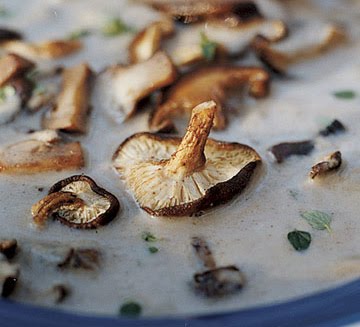
Here's a recipe I created for a healthy version of wild mushroom soup. It still tastes rich & creamy, but without all of the fat calories. Enjoy!
Wild Mushroom Soup
Ingredients:
1 Tbsp. extra virgin olive oil
1 Tbsp. butter
1 Tbsp. unbleached, all-purpose flour
1/2 yellow onion, finely minced
3 medium-sized garlic cloves, peeled & minced
2 shallots, finely minced
1/3 c. sherry
4 oz. mixed fresh, whole wild mushrooms (crimini, shiitake, porcini, oyster mushrooms, etc.) (equals 1 1/4 c. sliced)
8 oz. fresh, whole baby bella mushrooms (equals 2 1/2 c. sliced)
kosher salt & freshly ground black pepper, to taste
1 tsp. dried thyme leaves
1 tsp. dried parsley leaves
1/2 tsp. dried tarragon leaves
4 c. water
2/3 c. light non-dairy creamer (or plain, light/nonfat soy milk)
2 sprigs fresh thyme (for garnish)
Directions: Soak all mushrooms in a large bowl of warm water for 15-20 minutes. Wash them off & then drain. Slice mushrooms into small vertical strips & set aside. In a large sauce pot, sauté onion, garlic, & shallots in olive oil & butter on medium-high heat for 5-7 minutes, or until adequately softened (but not browned). Stir occasionally to keep ingredients from sticking to the bottom of the pan. Deglaze with sherry & cook until only a thin layer of liquid is left. Then, add sliced mushroom & season with salt to help them cook faster & release their moisture. Add the remaining spices & mix thoroughly. Cook mushrooms for about 10-15 minutes, stirring continuously. Whisk in flour & mix thoroughly with other ingredients. Add water & cook for another 30 minutes or so. Let cool for several minutes & then pour into a blender with creamer (or soy milk). Gently pulse just a few times until the mushrooms have barely been chopped; I personally think the soup tastes best when its consistency is a bit chunky, so that the texture of the mushrooms can be tasted/appreciated. Pour into two bowls. Garnish each bowl with a sprig of thyme & serve.
Alternate Preparation: To make this recipe vegan & even lower in fat, leave out the butter altogether & substitute light plain soy milk for the light nondairy creamer.
Yield: Serves 2.





